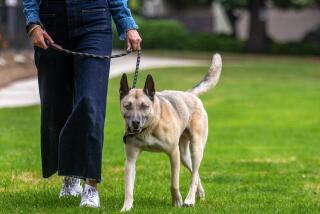DOG TRAINING : Head of the Class : Obedience school has the strange effect of turning your ill-behaved canine into the star pupil. But the experience is fleeting.
Maybe you killed too many brain cells in your youth. Or had temporary insanity. Or were blinded by cuteness.
But whatever was going on in your mind the day you brought home your dog, you now regret it fiercely.
Oh sure, she was endearing in the beginning. She was furry. She was cuddly. Her tiny body wagged along with her tail. You named her Shaka, an Indian word, a friend told you, meaning “good omen.”
Your friend lied.
Shaka now stands 6 feet tall on her hind legs and weighs 110 pounds. She knocks down your children. She chews on your antique table. She bolts out the door as you’re leaving for work, dances down the street and watches happily as you--sweating and cursing at the top of your lungs--chase her with the neighbors looking on.
Her name, you are convinced, is Swahili for “wretched one.”
You reach for the phone book.
Your fingers, smarter than you are, want to do the walking to Adoption Agencies or Animal Shelters. Instead, they end up on a page with an ad for an obedience school: “Have the dog,” the ad says, “you’ve always wanted.”
The dog you want at this point is one you can remember fondly from a great distance. But Elaine Bergem, the animal trainer who answers your phone call, tells you not to despair.
“All dogs dig and jump and chew. That’s because they’re dogs,” she says, reminding you of a book you once read that explained why some parents feel like throttling their teen-agers.
Bergem says she has been teaching dog obedience classes for 20 years and never once has a dog failed her course. “There is no such thing as an untrainable dog,” she says. “Only untrainable people.”
A seven-week, $55 course she has just started meets once a week in Camarillo. At the end of the sessions, she promises, your dog will sit, stay, come, lie down, heel and, in essence, be utterly transformed.
Before she signs you up, though, there are a few things she needs to know.
What kind of dog, she asks, do you have? There is a pause after you answer.
“Oh, that’s a very difficult combination,” she says slowly. “Great Danes aren’t easy to train, and Siberian huskies aren’t interested in anything but pulling sleds in snow country. . . .”
This last piece of information enlightens you. You now understand, you tell her, why just the other day Shaka took off down the sidewalk dragging your 8-year-old behind her on his chin.
She tells you where to show up.
It is Saturday morning at a neighborhood park, and 15 dogs and their untrained owners are gathered in a semi-circle. Bergem, standing in the center, barks instructions through a megaphone. Participants and their dogs are to form two lines, she says, with each facing the other. The humans and the animals then take a moment to check out their classmates.
There is a heavy-set man and what looks like a heavy-set Doberman, which turns out to be a Rottweiler. There is a woman with a pinched face and her schnauzer. A wiry-looking man with a wiry-looking mutt. A woman with strawberry-blond hair and her golden retriever.
You don’t want to know what your dog says about you.
Bergem then tells the group about the upcoming exercise. Each dog is to sit at its owner’s left side, she says. If the dog won’t sit, yank up on the choke chain and yell the command. A chorus of “Sit!” follows.
When you glance down out of the corner of your eyes, you are amazed at your well-behaved dog. The only move she makes is to cock her head in the direction of the schnauzer, now emitting a high-pitched whine.
Next comes heeling. Bergem holds a leash in her hands and demonstrates how an owner’s hands should move when making left, right or reverse turns. She then commands the owners: “Forward!” The owners comply. “Right turn!” Bergem yells.
You are facing Bergem and do not know if she means your right or her right. You head in the wrong direction. “ Right turn!” Bergem says.
Shaka is doing better than you are. With each sweep of the leash, she follows right beside you. When you yank up on her choke chain and stop, she sits automatically. “After a while of practicing this,” Bergem tells the group, “your dog will begin to sit automatically when you stop.”
Shaka is ahead of the class. Perhaps you owe her an apology.
Bergem then demonstrates how to make a dog lie down by pulling down on the choke chain. “This is a real test of the animal’s disposition,” she says, “because you are asking the dog to be subservient to you.” Many of the dogs are clearly not happy about this concept.
Jazz, a dog of dubious ancestry, begins snapping at its owner. The schnauzer wails uncontrollably. The Rottweiler puts both front paws on its owner’s shoulders. The retriever has locked its legs and refuses to budge. Shaka, with a gentle yank, goes without protest to the ground. She wags her tail furiously when you praise her.
Bergem then dismisses the class and tells everyone to practice during the coming week. For the first time, you are filled with hope.
She could learn to wipe her muddy paws before prancing onto the rug. She could gnaw on a bone instead of your favorite shoes. She could walk beside you to the park without taking off after a cat.
At home, you pull the car into the driveway and open the back door. Before you can stop her, she bolts past you and charges down the sidewalk.
You don’t care if the neighbors hear you or not.
But Shaka, rounding a corner in the distance, is impervious to your screams.
* THE PREMISE
There are plenty of things you have never tried. Fun things, dangerous things, character-building things. The Reluctant Novice tries them for you and reports the results. After all, the Novice gets paid to do them--and has no choice in the matter. If you want to tell the Novice where to go, please call us at 658-5547. If we use your idea, we’ll send you a present.
This week’s Reluctant Novice is staff writer Aurora Mackey.
More to Read
Sign up for Essential California
The most important California stories and recommendations in your inbox every morning.
You may occasionally receive promotional content from the Los Angeles Times.










